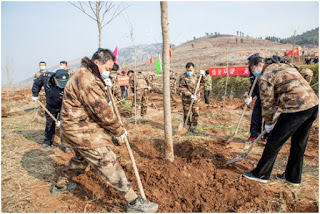By Kou Jiangze, By People’s Daily
COVID-19 isn’t able to stop China’s volunteering activities of tree planting.
Currently, villagers in Guozhao village, Deqing county, Huzhou of east China’s Zhejiang province are enthusiastically greening their hometown, while a tree planting activity held in Jiangwang community, Hanjiang district of Yangzhou, east China’s Jiangsu province attracted a large number of families to make their environment better.
Various places in the country are developing new methods to encourage people to participate in horticultural activities, as most people quarantined themselves at home when COVID-19 was rampant.
The afforestation committee under the forestry bureau in Jiangsu has launched horticultural courses, in which horticultural experts teach people how to cultivate plants and flowers at home and green the planet with efforts made on their own balconies.
“I have benefited a lot from the courses, because I learned how to keep plants, facelifted my house and fulfilled my duty to green the environment,” said a villager named Zhang Meijuan in Siyang county of Jiangsu province.
“Some people equate voluntary afforestation with planting trees only, however, it actually encompasses a wide variety of options,” an official with the National Forestry and Grassland Administration (NFGA) introduced.
Voluntary tree planting is carried out in a facilitated and flexible manner for wide participation, and it covers afforestation, cultivation and management, natural conservation, facility construction, donation and voluntary services, the official explained.
A woman named Li Ting from Tongzhou district of Beijing told People’s Daily that over three square meters of her balcony are covered by vegetation, which is equivalent to planting three trees. “I’m happy to fulfill my duty,” she said.
China made new strides in advancing afforestation in 2019. It created forests totaling nearly 7.07 million hectares, tended forests of over 7.73 million hectares and improved nearly 3.15 million hectares of degraded grasslands last year, according to a report on China’s 2019 afforestation released by the Office of the National Greening Commission of the NFGA in March.
China saw the most increase in forest resource and has the largest amount of planted forest in the world despite the dropping forest resource worldwide. Compared to four decades ago, the national forestry coverage in the country has grown approximately 10 percentage points, and the area covered by forest has increased by 80 percent.
In recent years, “Internet+” also contributed huge efforts to the expansion of China’s voluntary tree planting activities.
A 60-year-old Shanghai citizen surnamed Cai “adopted” a magnolia tree in Shanghai Botanical Garden through internet. “I hope this tree will raise the awareness of environmental protection for my eight-year-old grandson as the two grow together,” she said.
An online tree planting festival was launched by Ant Forest, a mini app on Chinese third-party mobile and online payment platform Alipay on March 12. It marked the first time for the mini app to launch the activity, aiming to encourage people to collect “green energy” points each time they reduce carbon emission – something that can be used to “water” virtual forests on the app. According to an employee of Alipay, a virtual forest “watered” by users across the nation will be turned into physical form in Wuhan to protect the ecology and people in the city.
“Those who partake in online tree planting activities will be awarded an electronic certificate issued by the Office of the National Greening Commission of the NFGA and the China Green Foundation, each with a serial number and a QR code. This is how we inspire the citizens in tree planting and strengthen their sense of fulfillment and honor,” said Zhang Jianlong, deputy director of the National Greening Commission and head of the NFGA.
Since the launch of Alipay’s Ant Forest project in August 2016, more than 70 cities in ten provinces have had their own virtual forests. The project has attracted 550 million users, more than one third of the country’s total population, and reduced carbon emissions by 11 million tons. So far, the project has planted a total of 122 million trees on China’s territory, covering an area of 1.68 million mu (about 11.2 hectares).
Citizens of Tengzhou, east China’s Shandong province participate in voluntary tree planting on March 6. (Photo by Song Haicun, People’s Daily Online)










Leave a Comment